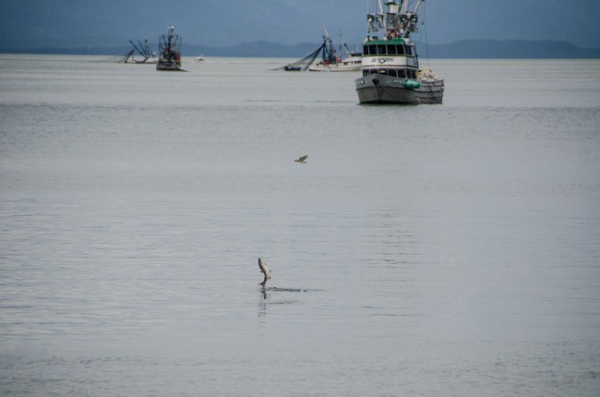
The first returns of hatchery chum salmon are showing up in fishing nets in Southeast Alaska this month. Summer chums play an important part in the early season for net fishing fleets and the troll fleet as well. Hatchery officials are forecasting runs close to last year’s.
A little lost in last year’s record setting pink salmon haul in Southeast was a strong catch for chum salmon. Last year seiners, gillnetters and trollers brought in 12.5 million dogs in the region. The bulk of those fish start their lives in hatcheries around the Panhandle and most return earlier in the summer than pinks. Fishery managers expect nearly as many chums this year but nowhere near last year’s record setting pink catch.
Juneau-based Douglas Island Pink and Chum expected a good year last year with a forecast of 2.7 million chums – but the actual returns were DIPAC’s biggest ever at nearly five million. Whether or not 2014 lives up to that standard, DIPAC executive director Eric Prestegard expects a strong run.
“Well the forecast is up from last year’s forecast. But last year came in well above forecast, so it’s below what returned last year but what we would call a very good forecast about 3.3 million.”
A big portion of DIPAC’s returns are expected back to release sites in Lynn Canal. And Prestegard thinks there are some good early signs for this year’s chums.
“The first gillnet opening certainly it looked pretty good from our eyes. That was about twice what we kinda would have forecasted to have happened. Again that’s just sort of built on some averages and what not so it’s not great data but it’s reasonable. So we thought that was good.”
On the flip side, Prestegard says trollers targeting chum along the Home Shore area of Icy Strait are not having the big season they had last year. Nevertheless, he says it’s the time of year to wait and see what comes back.
“Now’s when you sort of chew on your fingernails and wait for the days they fish and look at that data. You know we did take some samples from the first opener there in Lynn Canal. They were big beautiful fish, 10.9 pound average, which is very large for us and mostly five year olds. So that’s a good sign.”
Trolling has been open for spring fisheries in May and June, while gillnetters and seiners had their first openings in mid June.
Closer to Sitka, one point one million chum are forecast to return to Hidden Falls and Medvejie Deep Inlet. Those are two sites operated by the Sitka-based Northern Southeast Regional Aquaculture Association, or NSRAA.
Last year Hidden Falls saw a run of 1.3 million. Medvejie Deep Inlet doubled last year’s forecast with a return of 2.2 million. NSRAA general manager
Steve Reifenstuhl says he’d be happy with three percent survival rate for the chum released each year.
“And that would put the Medvejie run around 1.5 to 1.8 million annually and Hidden Falls, closer to, with three percent marine survival closer to two million annually. You know we’d love to see bigger than that but that’s what my hope is.”
Fishing started slow for seiners catching chum returning to both sites but Reifenstuhl was hopeful catches would be increasing. And Like Prestegard, Reifenstuhl says the fish so far this year are large.
“At this point all the data says the fish are big, over 10 pound average, which is fairly unusual and suggests they’re five year old fish. The bulk of the fish are typically four year old fish.”
Further to the south, the Southern Southeast Regional Aquaculture Association forecasts three point two million chums back at four different release sites around Ketchikan and Wrangell.
The largest return anticipated is 1.8 million at Neets Bay off of Behm Canal north of Ketchikan. Last year that run saw a return of just under a million fish.
The Ketchikan-based association’s Susan Doherty says they’re forecasting an average survival rate for summer run chum at four different release sites. If the forecast holds up it would beat last year’s summer chum total of just over two million. Other SSRAA fish return to Kendrick Bay on southern Prince of Wales Island, Anita Bay close to Wrangell and Nakat Inlet south of Ketchikan. Those returns typically start showing up a little later in the summer.
Joe Viechnicki is a reporter at KFSK in Petersburg.




